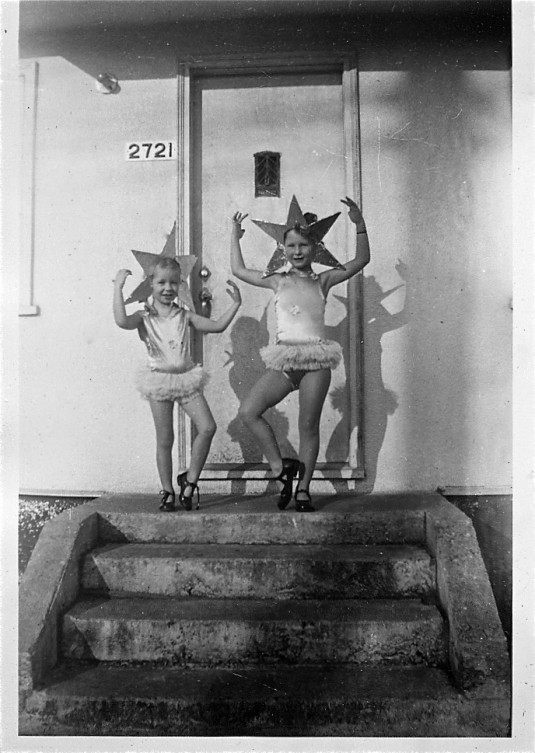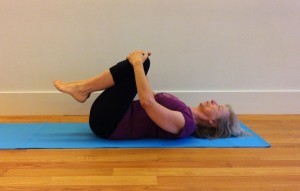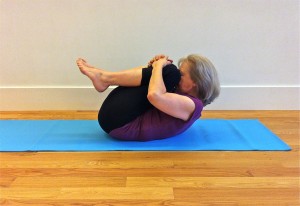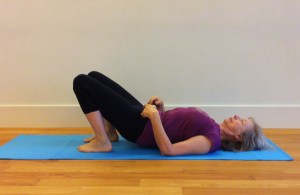
For some time now I have suspected that there might in fact be two kinds of people in the world: those who have a natural connection to their core, and those like me, the tap-dancing star on the left, who don’t. I dug that picture out just to confirm that yes, even when I was four, the pattern of a rounded upper back and saggy belly had already found a home in my body.
From the first time a gym teacher had us lie on our backs and slowly lower our legs, I’ve known that my abdominals were shockingly weak. Asana practice has made me much stronger. But if I had to pick a weakest spot, my core would be neck-and-neck for first place with my triceps.
Thing is, triceps aren’t particularly complicated. Abdominal muscles are a different story. In some poses, the actions were clear enough. But in others – Warrior III for example – I knew I was collapsing in my core, but I didn’t know what to do about it.
For the first time ever, I’m beginning to think that might change.
Recently I had what I think of as “the sides of the navel” revelation.
All the poses I’ve been most interested in lately – garland pose (Malasana), boat pose (Navasana), joint-freeing pose (Pavana Muktasana) and ear-pressure pose (Karnapidasana) – have one important thing in common.
They ask for a way of connecting to the abdominal muscles that I’ve never really understood before. And if you don’t connect, it’s hard to strengthen your abdominals.
The sides of the navel:
If you haven’t heard before that your navel has sides, here’s a way to imagine it: think of a line drawn on your skin about an inch away from each side of your navel.
The line has its starting point about two inches below your navel, and it ends about two inches above.
The line, of course, is energetic, not anatomical. It’s a lively, flexible line, capable of moving in two directions: from its lowest point, two inches below your navel, it gently scoops down from the surface of the skin, toward your spine, then lengthens along your spine, up toward your diaphragm.
You can get a sense of it if you set yourself up for pranayama practice with folded blankets supporting the back of your ribcage, but not your lumbar spine – a position in which you can feel the separation of your chest and abdominal cavities.
In this position, you can observe your inhalations, watching the sides of the navel flow inward, toward the spine, and up toward the diaphragm.
In a recent class, Louie linked this inhalation to boat pose, which also requires the sides of the navel to lengthen and moving toward the spine.
I was mulling it over a few days later when a light bulb appeared over my head.I had been focusing on the inhalation – but what about the exhalation?
I found that if I spread the skin of my back body on the exhalation, then the sides of my navel dropped even deeper, and my abdominal muscles spread sideways. If I repeated those actions over several breath cycles, I could feel my back body starting to wrap around, as though it was supporting and strengthening my core.
The Five-Minute Yoga Challenge:

Continue to keep the sides of your navel moving to your spine and lengthening as you draw your knees in.
It’s called Supta Pavana Muktasana (supine joint freeing pose) in Lois Steinberg’s Geeta S. Iyengar’s Guide to a Woman’s Yoga Practice, an essential book for any yoga library.
Lie down on your back in constructive rest position, knees bent, heels wider than your toes. Draw your shoulders under and lengthen your lower back.
With your inhalations, lengthen the sides of your navel, both down toward your spine, and up toward your diaphragm. With every exhalation, watch your back body spread on the floor.
Relax and let the rhythm become familiar.
Once you’re comfortable with the movement of your breath, lift your feet away from the floor and bring your knees a little closer to your chest. Be slow.

Keep your breathing soft, your neck and shoulders free from strain as you round up toward your knees.
Bring your arms around your knees. (You can hold at the back of your knees if compressing your knees is painful.)
Pay attention to the feeling of your back body wrapping around towards your legs and drawing them closer.
Keeping your neck and shoulders quiet, bring your forehead to touch your knees. Stay there and breathe for several cycles, then relax, and repeat.
When you’re done, stretch out in supine mountain pose (Supta Tadasana) to release any tension in your belly.
Stretch your heels away to lengthen your buttocks. Take your arms overhead, palms facing the ceiling, and stretch your back body towards your fingertips.
Work with this at least every second day for a week or two, and you may find a new connection into your core body, something that gives you more strength in a wide range of poses, including, yes, Warrior III.
owards your fingertips. Work with this at least every second day for a week or two, and you may find a new connection into your core body, something that gives you more strength in a wide range of poses, including, yes, Warrior III.
Asana photo credit: Baya Hammoudi
If this was your kind of post you might also like:
Find Your Bungee Cord: Five-Minute Yoga Challenge
Squeeze a Brick for Strength and Clarity in Your Legs: Five-Minute Yoga Challenge
Twist in a Chair to Free Your Back: Five-Minute Yoga Challenge





Comments on this entry are closed.
I find that some of the best advice I give to my students is on poses that I have/had to work hardest on . Thank you for sharing this post.
Eve,
This is so hard for me. Getting in touch with the sides of my navel is eluding me. Any other words to help me?
Claire, good to hear from you!
If I think about the way that I first really felt this action, it was something I think of as “scooping.”
You lie on your back in constructive rest position. Relax, let your back body spread on the floor. Then lift your pelvis an inch or two, roll your buttocks gently toward the backs of your knees, and wait for the feeling of your navel scooping toward your spine.
As you bring your back to the floor, keep gently drawing your buttocks toward the back of your knees. Stay there and see if you can continue to keep your navel softly scooping toward your spine.
I first started working with that a year and a bit ago, and I think becoming aware of that action helped me feel the sides of the navel.
I hope that helps. Let me know, okay?
Eve;
This is a monster-good abs strengthener.
Be in plank, with your toes on a blanket and your hands on a sticky mat. Round your upper back as you might for lolasana( our fave!). Then don’t use leg muscles, use the lift of the lower abs just above the pubis and the strength of the rounded upper back to draw your legs towards your hands.
Remember DON’T use the legs muscles. When the lower abs draw up towards the low ribs they, plus the strength of the upper back, connect the psoas and abs and voila! Do onece a day for 90 days and caturanga, navasana, and those IJ1 poses calling for upper back/abs/arms strength and integration can be done.
Hi Kelly,
I’m liking the sounds of this! Thanks for the great suggestion.
I’ll try it out in my next practice. Chatturanga, hey?
One question: the toes are in plank, yes? Not the tops of the feet on the floor? I’m just trying to imagine the pulling in.. .
Oh Eve,
Don’t be too harsh to that little girl on the left..she turned out to be a beautiful swan in the Yogic Lake. I love her!
I’m pretty fond of her too, Loura. I hope I wasn’t harsh – just curious to see how early body patterns can start.
Thank you Eve, your explanations are very clear. I will try it today.
Namaste. Baya
Baya! Good to hear from you. And thanks again for taking such good pictures.
Sweetest dancing star there ever was
Aw, thanks Patti.